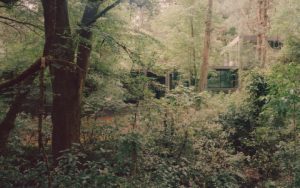Cross-laminated timber (CLT) is an engineered wood panel composed of multiple layers of dimensional lumber stacked perpendicularly and bonded with structural adhesives. This cross-directional arrangement delivers exceptional dimensional stability, high load-bearing capacity, and remarkable rigidity. CLT homes utilize these prefabricated panels as primary structural elements for walls, floors, and roofs, enabling rapid on-site assembly.
Environmental Sustainability
CLT serves as a renewable building material sourced from sustainably managed forests. Its production requires less energy than concrete or steel, and wood naturally sequesters carbon throughout its lifespan. By replacing carbon-intensive materials, CLT significantly reduces a building’s overall carbon footprint.
Speed of Construction
Panels are precision-manufactured off-site to architectural specifications. This prefabrication minimizes on-site labor and weather delays, accelerating project timelines by up to 50% compared to conventional methods. Modularity also simplifies complex designs while reducing waste.

Structural Performance
Cross-lamination provides superior strength-to-weight ratios and dimensional stability, resisting deformation under stress. CLT panels demonstrate excellent fire resistance through predictable charring behavior and perform reliably in seismic zones due to wood’s inherent flexibility and energy dissipation.
Thermal Efficiency
Wood’s natural insulating properties create high-performing thermal envelopes. Tight panel joints reduce air leakage, while consistent thickness eliminates thermal bridging. This translates to lower heating and cooling energy demands, exceeding conventional building efficiency standards.
Design Versatility
Architects leverage CLT’s adaptability for complex geometries and open-plan spaces without intrusive support beams. Exposed timber surfaces offer aesthetic warmth and biophilic benefits. The material’s machinability allows integration of conduits, ducts, and fittings during fabrication.





